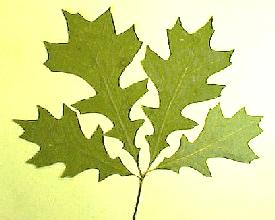
Tree to 25 m (80 ft) tall and 50 cm (20 in) diameter, with open crown of spreading branches. Bark gray to brown, smooth, becoming black and furrowed into flat scaly ridges. Twigs dark brown or gray, glabrous or sparsely pubescent, ending in a cluster of blunt brown buds. Leaves alternate, elliptic, 10-20 cm (4-8 in) long, 5-13 cm (2-5 in) wide, deeply divided into 5-7 narrow lobes ending in several bristle-tipped teeth, sinuses between lobes deep and wide, dull dark green above, pale green with tufts of hairs in vein axils below. Fruits are acorns maturing in the second year, egg-shaped, 2-3 cm (0.8-1.2 in) long, 1/3 to 1/2 enclosed by the thick scaly cup.
Distribution: Native to the lower Mississippi Valley and Gulf Coastal Plain from Alabama to Texas.
Habitat: wet floodplain forests
NWI status: FACW
Comment: Quercus is the ancient classical name for the European oaks; texana refers to Texas, where it was discovered.
Distribution in Oklahoma: rare in southern McCurtain and Choctaw Counties.
BACK
NEXT
RETURN TO INDEX
Last update: 9/17/99
 Go to Oklahoma Biological Survey Home Page
Go to Oklahoma Biological Survey Home Page
 Disclaimer
Disclaimer